Land Subsidence Detection in the Coastal Plain of Tabasco, Mexico Using Differential SAR Interferometry
Abstract
:1. Introduction
2. Materials and Methods
2.1. Study Area
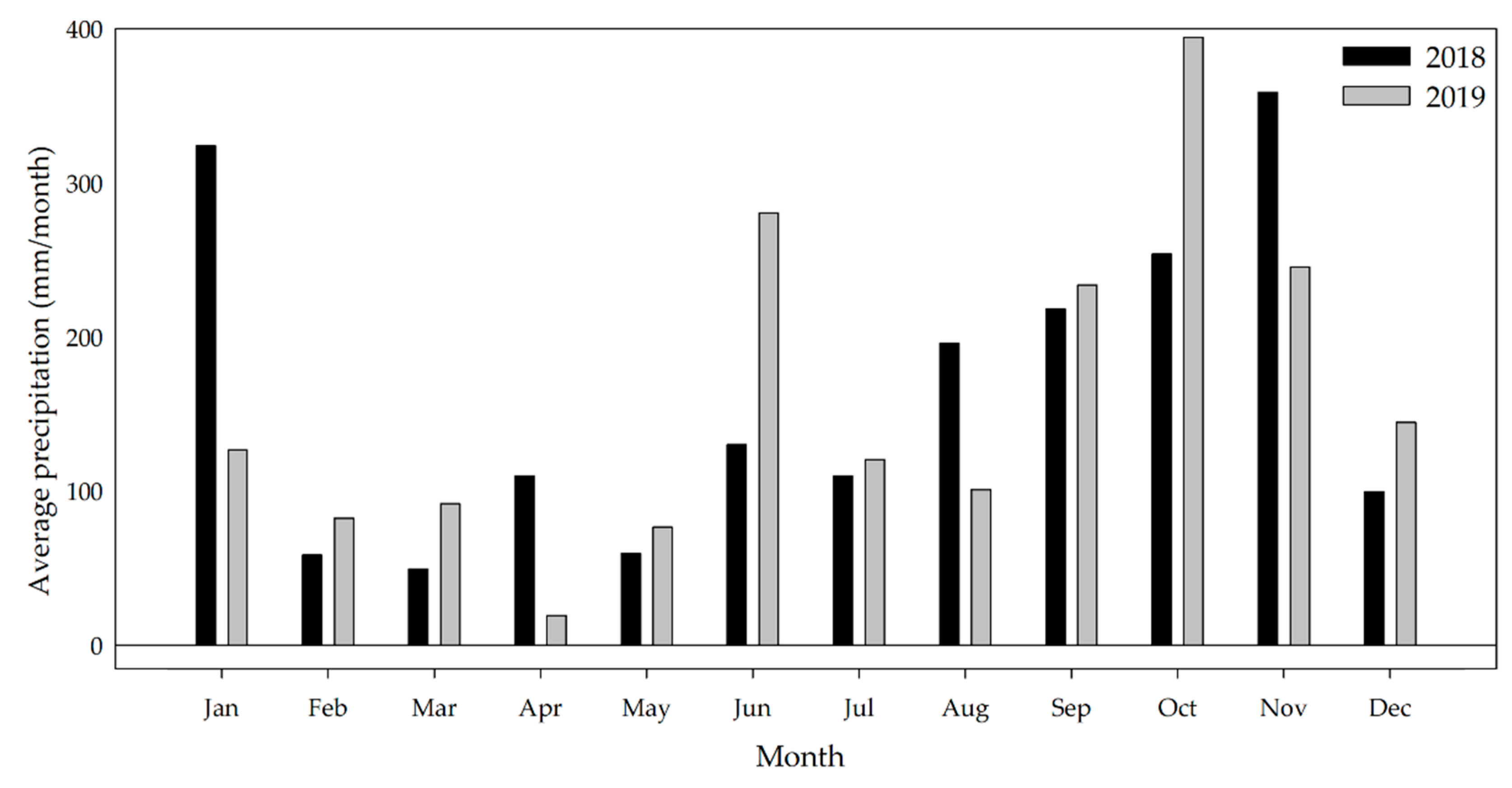
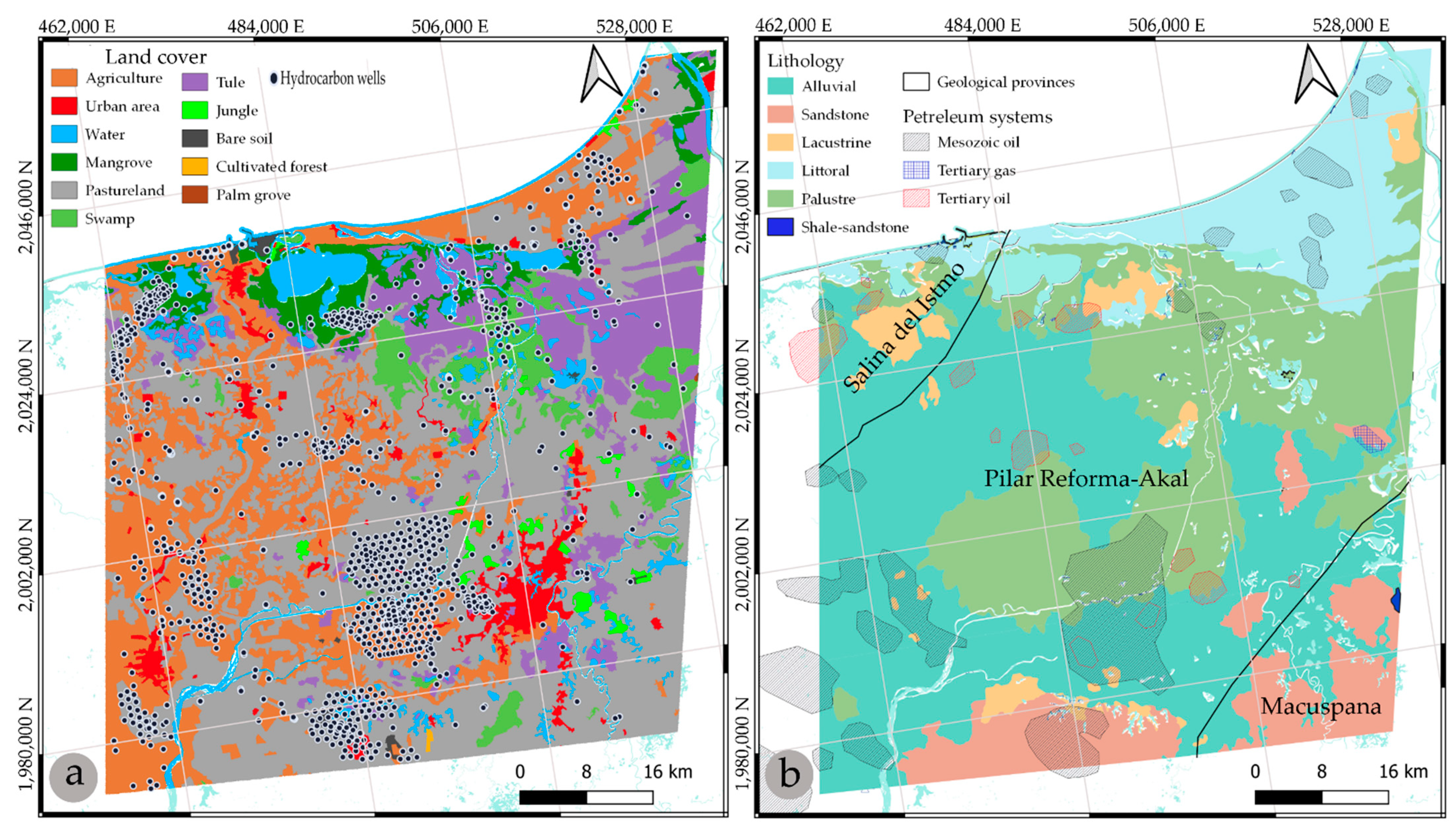
2.2. Data
2.3. SAR Differential Interferometry Background
2.4. DInSAR Processing
2.5. Identification of Flooded Areas
3. Results
3.1. Coherence Analysis
3.2. Flooded Areas and Interferometric Coherence
3.3. DInSAR Results Analysis
4. Discussion
5. Conclusions
Author Contributions
Funding
Institutional Review Board Statement
Informed Consent Statement
Data Availability Statement
Acknowledgments
Conflicts of Interest
References
- Prokopovich, N.P. Classification of Land Subsidence by Origin; IAHS-AISH Publication; International Association of Hydrological Sciences: Wallingford, UK, 1986; pp. 281–290. [Google Scholar]
- Marker, B.R. Land Subsidence. In Encyclopedia of Natural Hazards; Bobrowsky, P.T., Ed.; Springer Netherlands: Dordrecht, The Netherlands, 2013; pp. 583–590. [Google Scholar]
- Peltier, W.R. Global glacial isostasy and the surface of the ice-age Earth: The ICE-5G (VM2) Model and GRACE. Annu. Rev. Earth Planet. Sci. 2004, 32, 111–149. [Google Scholar] [CrossRef]
- Karegar, M.A.; Dixon, T.H.; Engelhart, S.E. Subsidence along the Atlantic Coast of North America: Insights from GPS and late Holocene relative sea level data. Geophys. Res. Lett. 2016, 43, 3126–3133. [Google Scholar] [CrossRef]
- Dokka, R.K. Modern-day tectonic subsidence in coastal Louisiana. Geology 2006, 34, 281–284. [Google Scholar] [CrossRef]
- Howell, S.; Smith-Konter, B.; Frazer, N.; Tong, X.; Sandwell, D. The vertical fingerprint of earthquake cycle loading in southern California. Nat. Geosci. 2016, 9, 611–614. [Google Scholar] [CrossRef]
- Sarah, D.; Hutasoit, L.M.; Delinom, R.M.; Sadisun, I.A. Natural Compaction of Semarang-Demak Alluvial Plain and Its Relationship to the Present Land Subsidence. Indones. J. Geosci. 2020, 7, 273–289. [Google Scholar] [CrossRef]
- Zhou, X.; Wang, G.; Wang, K.; Liu, H.; Lyu, H.; Turco, M.J. Rates of Natural Subsidence along the Texas Coast Derived from GPS and Tide Gauge Measurements (1904–2020). J. Surv. Eng. 2021, 147, 04021020. [Google Scholar] [CrossRef]
- Galloway, D.; Riley, F.S. San Joaquin Valley, California: Largest human alteration of the Earth’s surface. U.S. Geol. Surv. Circ. 1999, 1182, 23–34. [Google Scholar]
- Motagh, M.; Walter, T.R.; Sharifi, M.A.; Fielding, E.; Schenk, A.; Anderssohn, J.; Zschau, J. Land subsidence in Iran caused by widespread water reservoir overexploitation. Geophys. Res. Lett. 2008, 35. [Google Scholar] [CrossRef]
- Zhang, Y.; Gong, H.; Gu, Z.; Wang, R.; Li, X.; Zhao, W. Characterization of land subsidence induced by groundwater withdrawals in the plain of Beijing city, China. Hydrogeol. J. 2014, 22, 397–409. [Google Scholar] [CrossRef]
- Figueroa-Miranda, S.; Tuxpan-Vargas, J.; Ramos-Leal, J.A.; Hernández-Madrigal, V.M.; Villaseñor-Reyes, C.I. Land subsidence by groundwater over-exploitation from aquifers in tectonic valleys of Central Mexico: A review. Eng. Geol. 2018, 246, 91–106. [Google Scholar] [CrossRef]
- Martin, J.C.; Serdengecti, S.; Holzer, T.L. Subsidence over oil and gas fields. In Man-Induced Land Subsidence; Geological Society of America: Boulder, CO, USA, 1984; Volume 6, p. 23. [Google Scholar]
- Fielding, E.J.; Blom, R.G.; Goldstein, R.M. Rapid subsidence over oil fields measured by SAR interferometry. Geophys. Res. Lett. 1998, 25, 3215–3218. [Google Scholar] [CrossRef]
- Bayramov, E.; Buchroithner, M.; Kada, M.; Zhuniskenov, Y. Quantitative Assessment of Vertical and Horizontal Deformations Derived by 3D and 2D Decompositions of InSAR Line-of-Sight Measurements to Supplement Industry Surveillance Programs in the Tengiz Oilfield (Kazakhstan). Remote Sens. 2021, 13, 2579. [Google Scholar] [CrossRef]
- Allis, R.G. Review of subsidence at Wairakei field, New Zealand. Geothermics 2000, 29, 455–478. [Google Scholar] [CrossRef]
- Fialko, Y.; Simons, M. Deformation and seismicity in the Coso geothermal area, Inyo County, California: Observations and modeling using satellite radar interferometry. J. Geophys. Res. Solid Earth 2000, 105, 21781–21793. [Google Scholar] [CrossRef]
- Sarychikhina, O.; Glowacka, E.; Robles, B. Multi-sensor DInSAR applied to the spatiotemporal evolution analysis of ground surface deformation in Cerro Prieto basin, Baja California, Mexico, for the 1993–2014 period. Nat. Hazards 2018, 92, 225–255. [Google Scholar] [CrossRef]
- Samsonov, S.; d’Oreye, N.; Smets, B. Ground deformation associated with post-mining activity at the French–German border revealed by novel InSAR time series method. Int. J. Appl. Earth Obs. Geoinf. 2013, 23, 142–154. [Google Scholar] [CrossRef]
- Grzovic, M.; Ghulam, A. Evaluation of land subsidence from underground coal mining using TimeSAR (SBAS and PSI) in Springfield, Illinois, USA. Nat. Hazards 2015, 79, 1739–1751. [Google Scholar] [CrossRef]
- Strozik, G.; Jendruś, R.; Manowska, A.; Popczyk, M. Mine Subsidence as a Post-Mining Effect in the Upper Silesia Coal Basin. Pol. J. Environ. Stud. 2016, 25, 777–785. [Google Scholar] [CrossRef]
- Demin, D.; Fengshan, M.; Zhang, Y.; Wang, J.; Guo, J. Characteristics of Land Subsidence Due to Both High-Rise Building and Exploitation of Groundwater in Urban Are. J. Eng. Geol. 2011, 19, 433–439. [Google Scholar]
- Yuan, L.; Cui, Z.-D.; Yang, J.-Q.; Jia, Y.-J. Land subsidence induced by the engineering-environmental effect in Shanghai, China. Arab. J. Geosci. 2020, 13, 251. [Google Scholar] [CrossRef]
- Turner, E.R. Coastal wetland subsidence arising from local hydrologic manipulations. Estuaries 2004, 27, 265–272. [Google Scholar] [CrossRef]
- Ma, F.; Sui, L. Investigation on Mining Subsidence Based on Sentinel-1A Data by SBAS-InSAR technology-Case Study of Ningdong Coalfield, China. Earth Sci. Res. J. 2020, 24, 373–386. [Google Scholar] [CrossRef]
- Erkens, G.; Bucx, T.; Dam, R.; de Lange, G.; Lambert, J. Sinking coastal cities. Proc. IAHS 2015, 372, 189–198. [Google Scholar] [CrossRef]
- Liu, Y.; Li, J.; Fasullo, J.; Galloway, D.L. Land subsidence contributions to relative sea level rise at tide gauge Galveston Pier 21, Texas. Sci. Rep. 2020, 10, 17905. [Google Scholar] [CrossRef]
- Nicholls, R.J.; Lincke, D.; Hinkel, J.; Brown, S.; Vafeidis, A.T.; Meyssignac, B.; Hanson, S.E.; Merkens, J.-L.; Fang, J. A global analysis of subsidence, relative sea-level change and coastal flood exposure. Nat. Clim. Chang. 2021, 11, 338–342. [Google Scholar] [CrossRef]
- Zhou, X.; Chang, N.-B.; Li, S. Applications of SAR Interferometry in Earth and Environmental Science Research. Sensors 2009, 9, 1876–1912. [Google Scholar] [CrossRef]
- Gabriel, A.K.; Goldstein, R.M.; Zebker, H.A. Mapping small elevation changes over large areas: Differential radar interferometry. J. Geophys. Res. Solid Earth 1989, 94, 9183–9191. [Google Scholar] [CrossRef]
- Massonnet, D.; Feigl, K.L. Radar interferometry and its application to changes in the Earth’s surface. Rev. Geophys. 1998, 36, 441–500. [Google Scholar] [CrossRef]
- Bürgmann, R.; Rosen, P.A.; Fielding, E.J. Synthetic Aperture Radar Interferometry to Measure Earth’s Surface Topography and Its Deformation. Annu. Rev. Earth Planet. Sci. 2000, 28, 169–209. [Google Scholar] [CrossRef]
- Hanssen, R.F. Radar Interferometry: Data Interpretation and Error Analysis; Kluwer Academic Publishers: Dordrecht, The Netherlands, 2001; p. 308. [Google Scholar]
- Zebker, H.A.; Villasenor, J. Decorrelation in interferometric radar echoes. IEEE Trans. Geosci. Remote Sens. 1992, 30, 950–959. [Google Scholar] [CrossRef]
- Ferretti, A.; Prati, C.; Rocca, F. Permanent scatterers in SAR interferometry. IEEE Trans. Geosci. Remote Sens. 2001, 39, 8–20. [Google Scholar] [CrossRef]
- Berardino, P.; Fornaro, G.; Lanari, R.; Sansosti, E. A new algorithm for surface deformation monitoring based on small baseline differential SAR interferograms. IEEE Trans. Geosci. Remote Sens. 2002, 40, 2375–2383. [Google Scholar] [CrossRef] [Green Version]
- Hooper, A. A multi-temporal InSAR method incorporating both persistent scatterer and small baseline approaches. Geophys. Res. Lett. 2008, 35, 16. [Google Scholar] [CrossRef]
- Aparicio, J.; Martínez-Austria, P.F.; Güitrón, A.; Ramírez, A.I. Floods in Tabasco, Mexico: A diagnosis and proposal for courses of action. J. Flood Risk Manag. 2009, 2, 132–138. [Google Scholar] [CrossRef]
- Gama, L.; Ordoñez, E.M.; Villanueva-García, C.; Ortiz-Pérez, M.A.; Lopez, H.D.; Torres, R.C.; Valadez, M.E.M. Floods In Tabasco Mexico History And Perspectives. WIT Trans. Ecol. Environ. 2010, 133, 25–33. [Google Scholar]
- Da Lio, C.; Tosi, L. Land subsidence in the Friuli Venezia Giulia coastal plain, Italy: 1992–2010 results from SAR-based interferometry. Sci. Total Environ. 2018, 633, 752–764. [Google Scholar] [CrossRef]
- Di Paola, G.; Alberico, I.; Aucelli, P.P.C.; Matano, F.; Rizzo, A.; Vilardo, G. Coastal subsidence detected by Synthetic Aperture Radar interferometry and its effects coupled with future sea-level rise: The case of the Sele Plain (Southern Italy). J. Flood Risk Manag. 2018, 11, 191–206. [Google Scholar] [CrossRef]
- Hung, W.-C.; Hwang, C.; Chen, Y.-A.; Zhang, L.; Chen, K.-H.; Wei, S.-H.; Huang, D.-R.; Lin, S.-H. Land Subsidence in Chiayi, Taiwan, from Compaction Well, Leveling and ALOS/PALSAR: Aquaculture-Induced Relative Sea Level Rise. Remote Sens. 2018, 10, 40. [Google Scholar] [CrossRef]
- Nguyen Hao, Q.; Takewaka, S. Detection of Land Subsidence in Nam Dinh Coast by Dinsar Analyses. In Proceedings of the International Conference on Asian and Pacific Coasts, Singapore, 25–28 September 2020; pp. 1287–1294. [Google Scholar]
- Bayramov, E.; Buchroithner, M.; Kada, M.; Duisenbiyev, A.; Zhuniskenov, Y. Multi-Temporal SAR Interferometry for Vertical Displacement Monitoring from Space of Tengiz Oil Reservoir Using SENTINEL-1 and COSMO-SKYMED Satellite Missions. Front. Environ. Sci. 2022, 10, 783351. [Google Scholar] [CrossRef]
- Haley, M.; Ahmed, M.; Gebremichael, E.; Murgulet, D.; Starek, M. Land Subsidence in the Texas Coastal Bend: Locations, Rates, Triggers, and Consequences. Remote Sens. 2022, 14, 192. [Google Scholar] [CrossRef]
- Pérez-Falls, Z.; Martínez-Flores, G. Land Subsidence in Villahermosa Tabasco Mexico, Using Radar Interferometry; Springer Nature: Cham, Switzerland, 2020; pp. 18–29. [Google Scholar]
- Zavala-Cruz, J.; Palma-López, D.J.; Fernández-Cabrera, C.R.; López-Castañeda, A.; Shirma-Torres, E. Degradación y Conservación de Suelos en la Cuenca del río Grijalva, Tabasco; Secretaría de Recursos Naturales y Protección Ambiental, Colegio de Postgraduados, Campus Tabasco: Villahermosa, Tabasco, México, 2011. [Google Scholar]
- Palma-López, D.J.; Cisneros-Domínguez, J.; Moreno-Cáliz, E.; Rincón-Ramírez, J.A. Suelos de Tabasco: Su uso y Manejo Sustentable; Colegio de Postgraduados-Campus Tabasco, Instituto para el Desarrollo de Sistemas de Producción del Territorio Húmedo de Tabasco, Fundación Produce Tabasca: Villahermosa, Tabasco, México, 2007. [Google Scholar]
- Vazquez-Meneses, M.E.; España-Pinto, A.; Rosales-Contreras, E.; Rosales-Rodriguez, J.; Ruiz-Violante, A.; del Valle-Reyes, A. Structural evolution in the Tabasco Coastal Plain, Mexico. Gulf Coast Assoc. Geol. Soc. Trans. 2011, 61, 671–674. [Google Scholar]
- Krasilnikov, P.; Gutiérrez-Castorena, M.D.C.; Ahrens, R.; Cruz-Gaistardo, C.; Sedov, S.; Solleiro-Rebolledo, E. The Soils of Mexico; Springer Dordrecht: Madison, WI, USA, 2013. [Google Scholar]
- Zavala-Cruz, J. Actualización de la clasificación de suelos de Tabasco, México. Agro Product. 2018, 10, 29–35. [Google Scholar]
- García-Amaro, E. Modificaciones al Sistema de Clasificación Climática de Köppen, 5th ed.; Instituto de Geografía, UNAM: Mexico City, México, 2004. [Google Scholar]
- Perevochtchikova, M.; Lezama de la Torre, J.L. Causas de un desastre: Inundaciones del 2007 en Tabasco, México. J. Lat. Am. Geogr. 2010, 9, 73–98. [Google Scholar] [CrossRef]
- Copernicus. EMSR479: Flood in Tabasco, Mexico. Available online: https://emergency.copernicus.eu/mapping/list-of-components/EMSR479 (accessed on 20 April 2022).
- CONAGUA. Resúmenes Mensuales de Temperaturas y Lluvia. Available online: https://smn.conagua.gob.mx/es/climatologia/temperaturas-y-lluvias/resumenes-mensuales-de-temperaturas-y-lluvias (accessed on 25 April 2022).
- CNH. Atlas Geológico Cuencas del Sureste-Cinturón Plegado de la Sierra de Chiapas. Available online: https://hidrocarburos.gob.mx/media/3094/atlas_geologico_cuencas_sureste_v3.pdf (accessed on 1 August 2022).
- Chavez Valois, V.M.; Valdés, M.d.L.C.; Juárez Placencia, J.I.; Ortiz, I.A.; Jurado, M.M.; Yánez, R.V.; Tristán, M.G.; Ghosh, S.; Bartolini, C.; Ramos, J.R.R. A New Multidisciplinary Focus in the Study of the Tertiary Plays in the Sureste Basin, Mexico. In Petroleum Systems in the Southern Gulf of Mexico; American Association of Petroleum Geologists: Tulsa, OK, USA, 2009; Volume 90, Available online: https://pubs.geoscienceworld.org/books/book/1892/chapter-abstract/107094861/A-New-Multidisciplinary-Focus-in-the-Study-of-the?redirectedFrom=fulltext (accessed on 2 July 2022).
- Ketelaar, V.B.H. Subsidence Due to Hydrocarbon Production in the Netherlands. In Satellite Radar Interferometry: Subsidence Monitoring Techniques; Ketelaar, V.B.H., Ed.; Springer Netherlands: Dordrecht, The Netherlands, 2009; Volume 14, pp. 7–26. [Google Scholar]
- Fatholahi, S.N.; He, H.; Wang, L.; Syed, A.; Li, J. Monitoring Surface Deformation Over Oilfield Using MT-Insar and Production Well Data. In Proceedings of the 2021 IEEE International Geoscience and Remote Sensing Symposium IGARSS, Virtual, 11–16 July 2021; pp. 2298–2301. [Google Scholar]
- Allen, D.R.; Mayuga, M.N. The mechanics of compaction and rebound, Wilmington oil field, Long Beach, California, USA. In Land Subsidence; Tison, L.J., Ed.; International Association of Scientific Hydrology, UNESCO: Wallingford, UK, 1970; pp. 66–79. [Google Scholar]
- INEGI. Uso del Suelo y Vegetación, Escala 1:250,000. Available online: http://www.conabio.gob.mx/informacion/gis/?vns=gis_root/usv/inegi/usv250s6gw (accessed on 9 May 2022).
- IICNIH. Ubicación de Exploración, Perforación y Producción Petrolera. Available online: https://mapa.hidrocarburos.gob.mx/ (accessed on 9 May 2022).
- ESA. Sentinel-1 SAR Technical Guide. Available online: https://sentinels.copernicus.eu/web/sentinel/technical-guides/sentinel-1-sar (accessed on 26 May 2022).
- Zan, F.D.; Guarnieri, A.M. TOPSAR: Terrain Observation by Progressive Scans. IEEE Trans. Geosci. Remote Sens. 2006, 44, 2352–2360. [Google Scholar] [CrossRef]
- Yagüe-Martínez, N.; Prats-Iraola, P.; González, F.R.; Brcic, R.; Shau, R.; Geudtner, D.; Eineder, M.; Bamler, R. Interferometric Processing of Sentinel-1 TOPS Data. IEEE Trans. Geosci. Remote Sens. 2016, 54, 2220–2234. [Google Scholar] [CrossRef] [Green Version]
- Torres, R.; Snoeij, P.; Geudtner, D.; Bibby, D.; Davidson, M.; Attema, E.; Potin, P.; Rommen, B.; Floury, N.; Brown, M.; et al. GMES Sentinel-1 mission. Remote Sens. Environ. 2012, 120, 9–24. [Google Scholar] [CrossRef]
- Farr, T.G.; Rosen, P.A.; Caro, E.; Crippen, R.; Duren, R.; Hensley, S.; Kobrick, M.; Paller, M.; Rodriguez, E.; Roth, L.; et al. The Shuttle Radar Topography Mission. Rev. Geophys. 2007, 45, RG2004. [Google Scholar] [CrossRef]
- Anusha, N.; Bharathi, B. Flood detection and flood mapping using multi-temporal synthetic aperture radar and optical data. Egypt. J. Remote Sens. Space Sci. 2020, 23, 207–219. [Google Scholar] [CrossRef]
- Dao, P.D.; Liou, Y.-A. Object-Based Flood Mapping and Affected Rice Field Estimation with Landsat 8 OLI and MODIS Data. Remote Sens. 2015, 7, 5077–5097. [Google Scholar] [CrossRef]
- Pepe, A.; Calò, F. A Review of Interferometric Synthetic Aperture RADAR (InSAR) Multi-Track Approaches for the Retrieval of Earth’s Surface Displacements. Appl. Sci. 2017, 7, 1264. [Google Scholar] [CrossRef]
- Zhang, Y.; Prinet, V. InSAR coherence estimation. In Proceedings of the IGARSS 2004, 2004 IEEE International Geoscience and Remote Sensing Symposium, Anchorage, AK, USA, 20–24 September 2004; Volume 3355, pp. 3353–3355. [Google Scholar]
- Ma, G.; Zhao, Q.; Wang, Q.; Liu, M. On the Effects of InSAR Temporal Decorrelation and Its Implications for Land Cover Classification: The Case of the Ocean-Reclaimed Lands of the Shanghai Megacity. Sensors 2018, 18, 2939. [Google Scholar] [CrossRef] [PubMed]
- Wegnüller, U.; Werner, C.; Strozzi, T.; Wiesmann, A.; Frey, O.; Santoro, M. Sentinel-1 Support in the GAMMA Software. Procedia Comput. Sci. 2016, 100, 1305–1312. [Google Scholar] [CrossRef]
- Wegnüller, U.; Werner, C. Gamma SAR processor and Interferometry Software. In Proceedings of the Proceedings 3rd ERS Scientific Symposium, Florence, Italy, 17–20 March 1997. [Google Scholar]
- GAMMA Remote Sensing AG. Sentinel-1 Processing with GAMMA Software: Documentation User’s Guide; GAMMA Remote Sensing AG: Gümligen, Switzerland, 2015; p. 38. [Google Scholar]
- Goldstein, R.M.; Werner, C.L. Radar interferogram filtering for geophysical applications. Geophys. Res. Lett. 1998, 25, 4035–4038. [Google Scholar] [CrossRef]
- Costantini, M. A novel phase unwrapping method based on network programming. IEEE Trans. Geosci. Remote Sens. 1998, 36, 813–821. [Google Scholar] [CrossRef]
- Costantini, M.; Rosen, P.A. A generalized phase unwrapping approach for sparse data. In Proceedings of the IEEE 1999 International Geoscience and Remote Sensing Symposium, IGARSS’99 (Cat. No.99CH36293), Hamburg, Germany, 28 June–2 July 1999; Volume 261, pp. 267–269. [Google Scholar]
- Beauducel, F.; Briole, P.; Froger, J.-L. Volcano-wide fringes in ERS synthetic aperture radar interferograms of Etna (1992–1998): Deformation or tropospheric effect? J. Geophys. Res. Solid Earth 2000, 105, 16391–16402. [Google Scholar] [CrossRef]
- Bekaert, D.P.S.; Walters, R.J.; Wright, T.J.; Hooper, A.J.; Parker, D.J. Statistical comparison of InSAR tropospheric correction techniques. Remote Sens. Environ. 2015, 170, 40–47. [Google Scholar] [CrossRef]
- Psomiadis, E. Flash Flood Area Mapping Utilising SENTINEL-1 Radar Data; SPIE: Washington, DC, USA, 2016; Volume 10005. [Google Scholar]
- Tavus, B.; Kocaman, S.; Nefeslioglu, H.A.; Gökçeoğlu, C. Flood Mapping Using Sentinel-1 SAR Data: A Case Study of Ordu 8 August 2018 Flood. Int. J. Environ. 2019, 6, 333–337. [Google Scholar] [CrossRef]
- Ratna, R.D.; Neelima, G. Image Segmentation by using Histogram Thresholding. Int. J. Comp. Sci. Eng. Technol. 2012, 2, 776–779. [Google Scholar]
- ESA. Sentinel Application Platform v.7.0. Available online: http://step.esa.int/main/toolboxes/snap/ (accessed on 18 November 2018).
- Strozzi, T.; Wegmüller, U.; Tosi, L.; Bitelli, G.; Spreckels, V. Land subsidence monitoring with differential SAR Interferometry. Photogramm. Eng. Remote Sens. 2001, 67, 1261–1270. [Google Scholar]
- Wegmüller, U.; Werner, C.; Strozzi, T.; Wiesmann, A. Application of SAR Interferometric techniques for surface deformation monitoring. In Proceedings of the 12th FIG Symposium, Baden, Austria, 22–24 May 2006. [Google Scholar]
- Wegmüller, U.; Strozzi, T. Diferential SAR Interferometry for Land Subsidence Monitoring: Methodology and examples. In Proceedings of the International Symposium on Land Subsidence, Ravenna, Italy, 25–29 September 2000. [Google Scholar]
- Areu-Rangel, O.S.; Cea, L.; Bonasia, R.; Espinosa-Echavarria, V.J. Impact of Urban Growth and Changes in Land Use on River Flood Hazard in Villahermosa, Tabasco (Mexico). Water 2019, 11, 304. [Google Scholar] [CrossRef]
- Aslan, G.; Cakir, Z.; Lasserre, C.; Renard, F. Investigating Subsidence in the Bursa Plain, Turkey, Using Ascending and Descending Sentinel-1 Satellite Data. Remote Sens. 2019, 11, 85. [Google Scholar] [CrossRef]
- Santoro, M.; Wegmuller, U.; Askne, J.I.H. Signatures of ERS–Envisat Interferometric SAR Coherence and Phase of Short Vegetation: An Analysis in the Case of Maize Fields. IEEE Trans. Geosci. Remote Sens. 2010, 48, 1702–1713. [Google Scholar] [CrossRef]
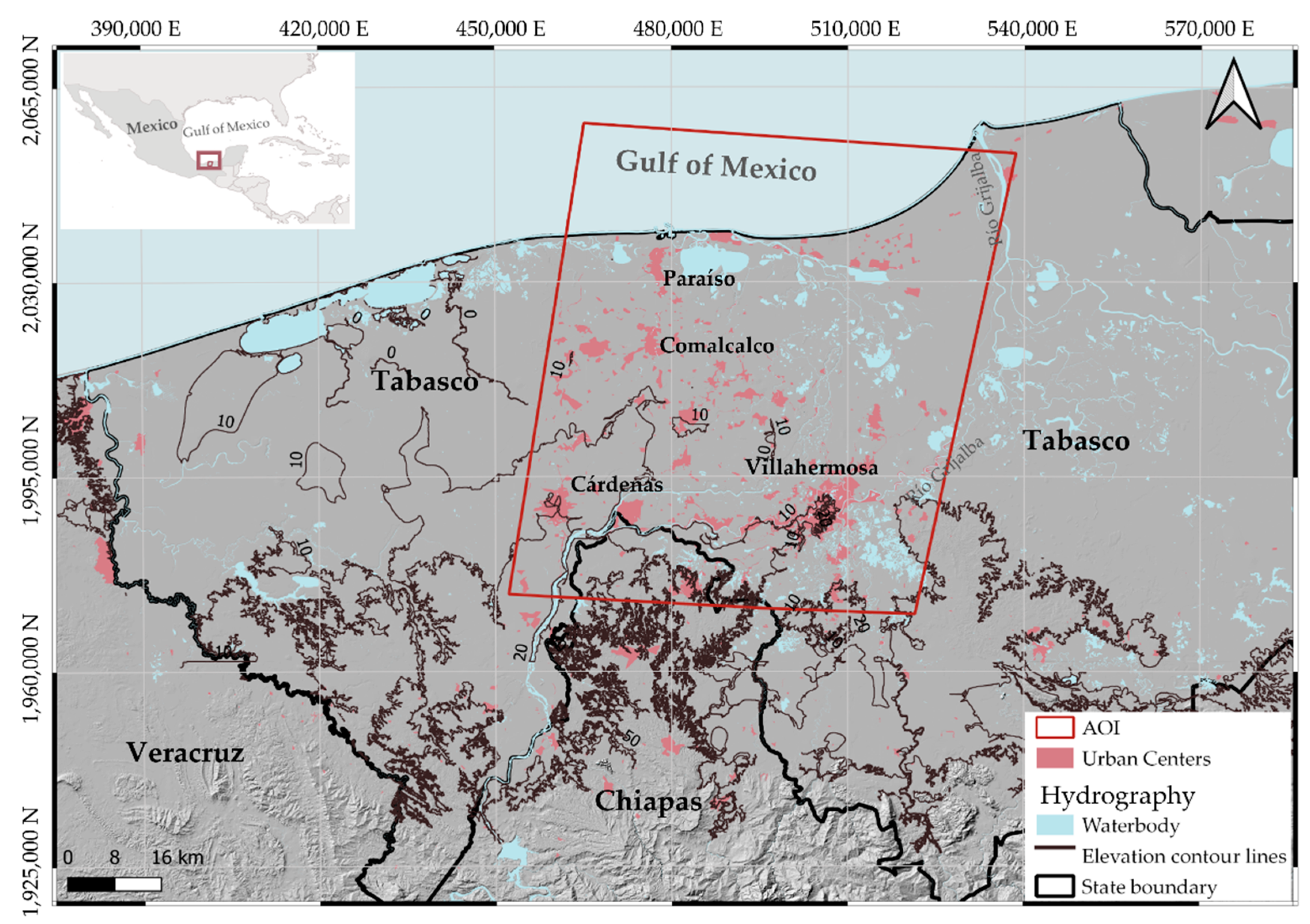
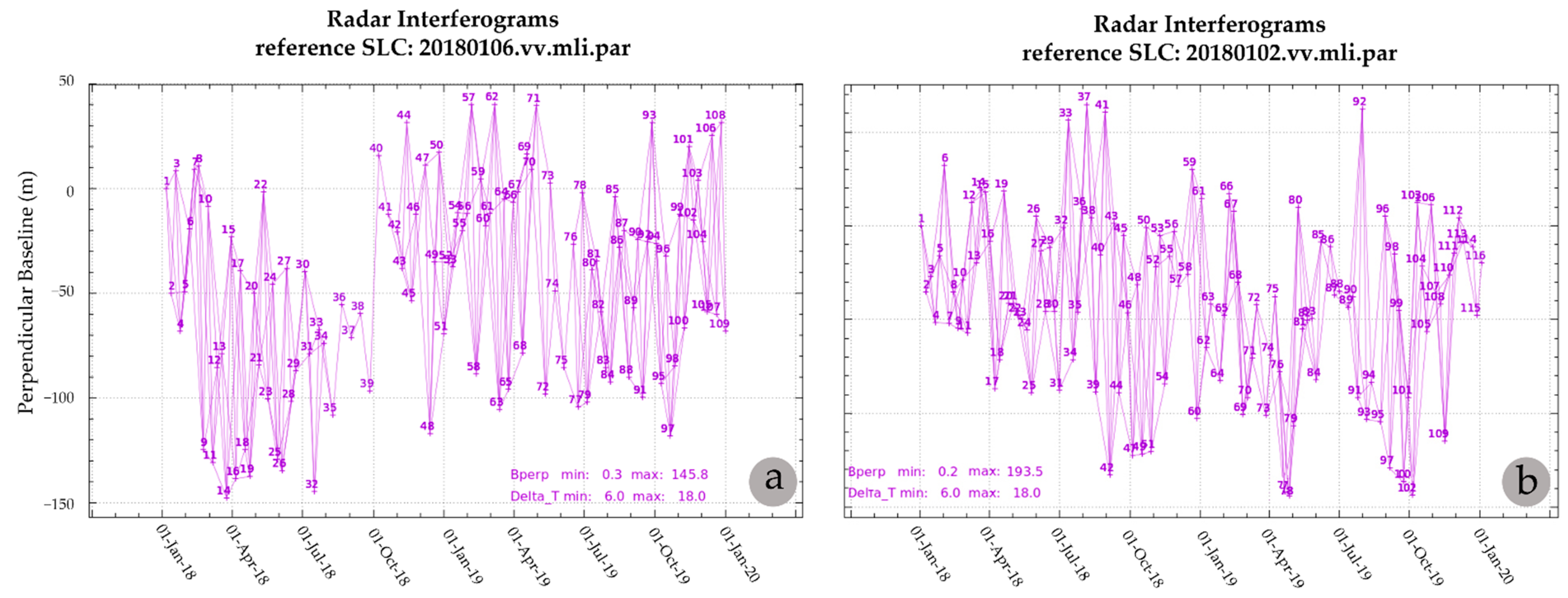
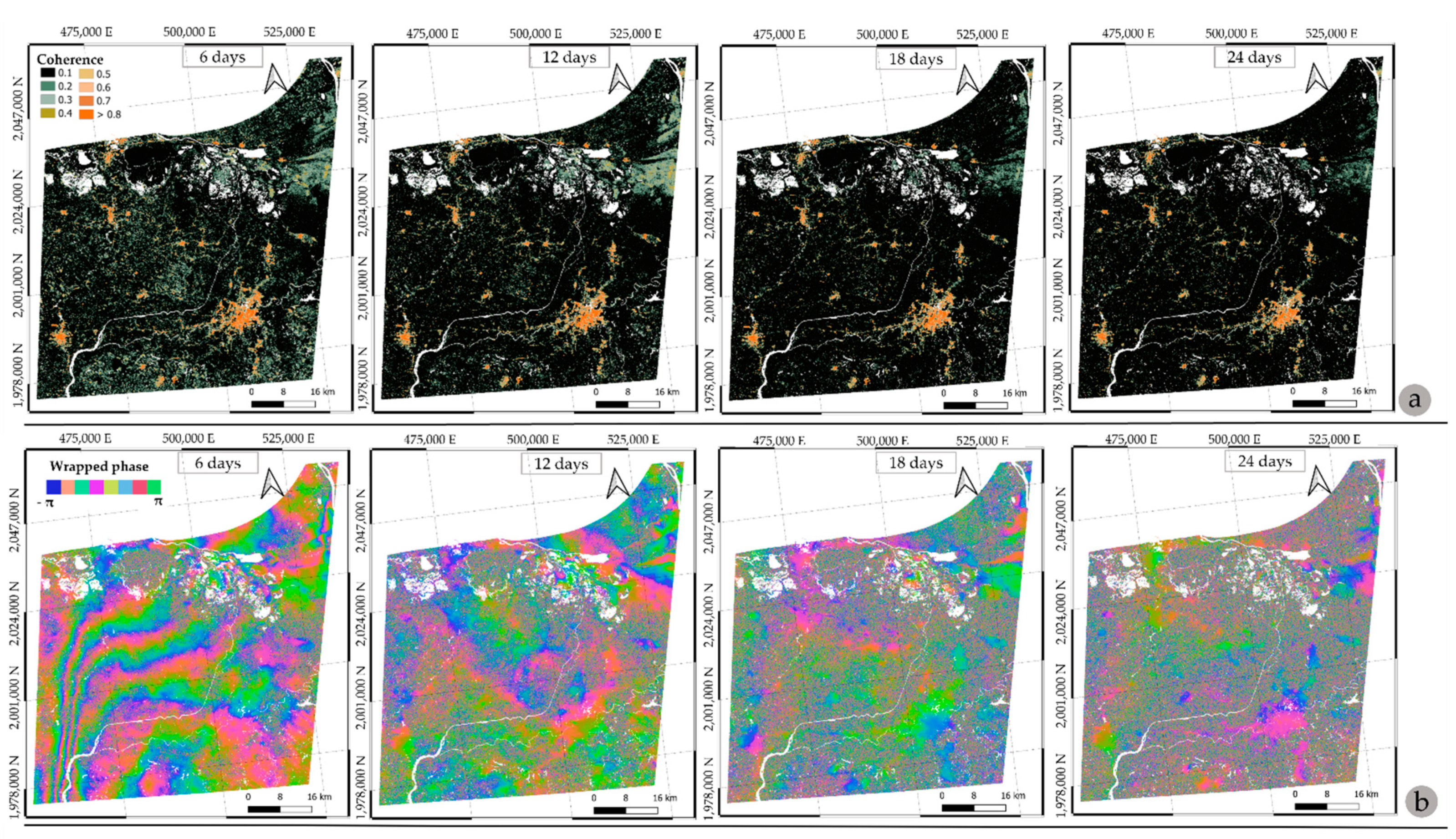

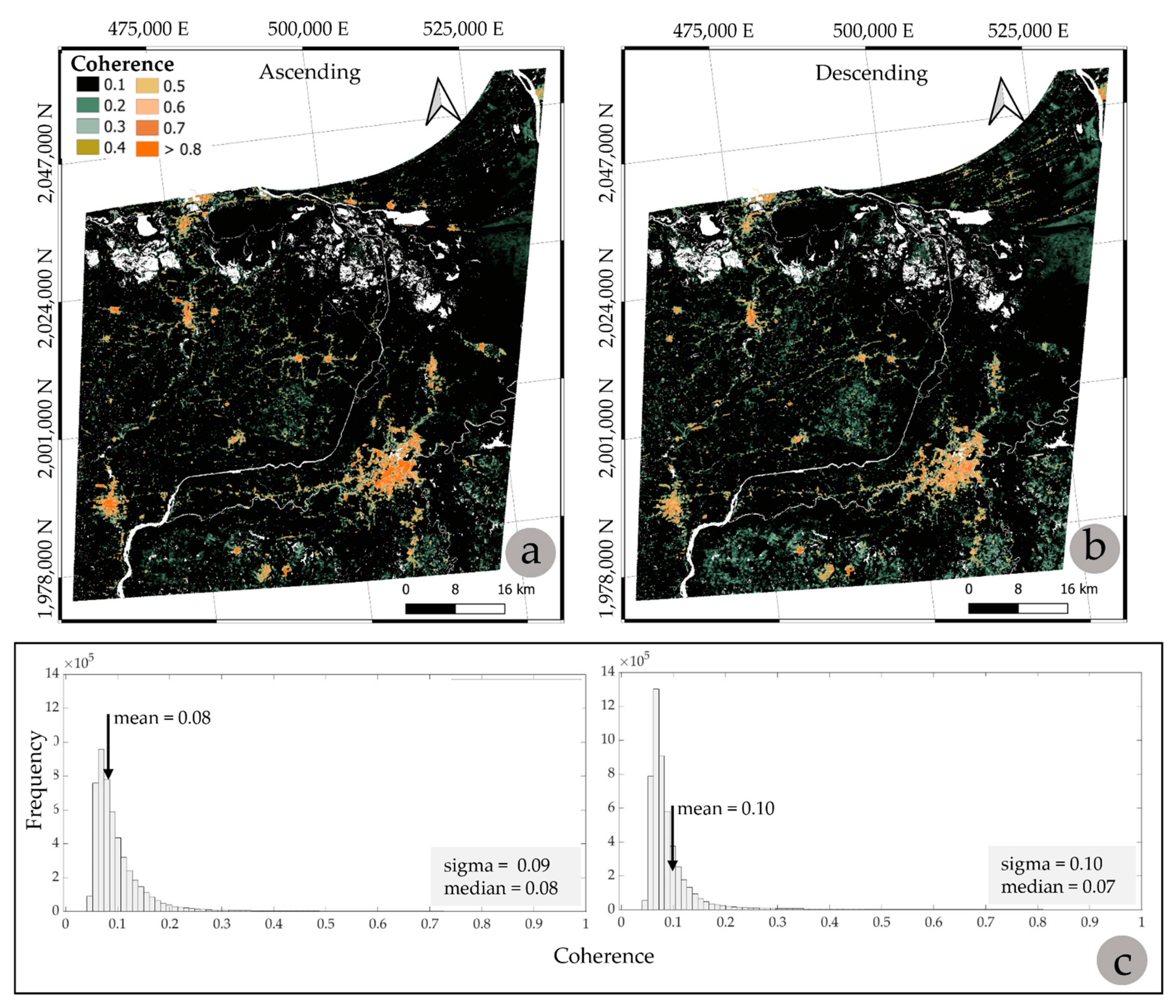
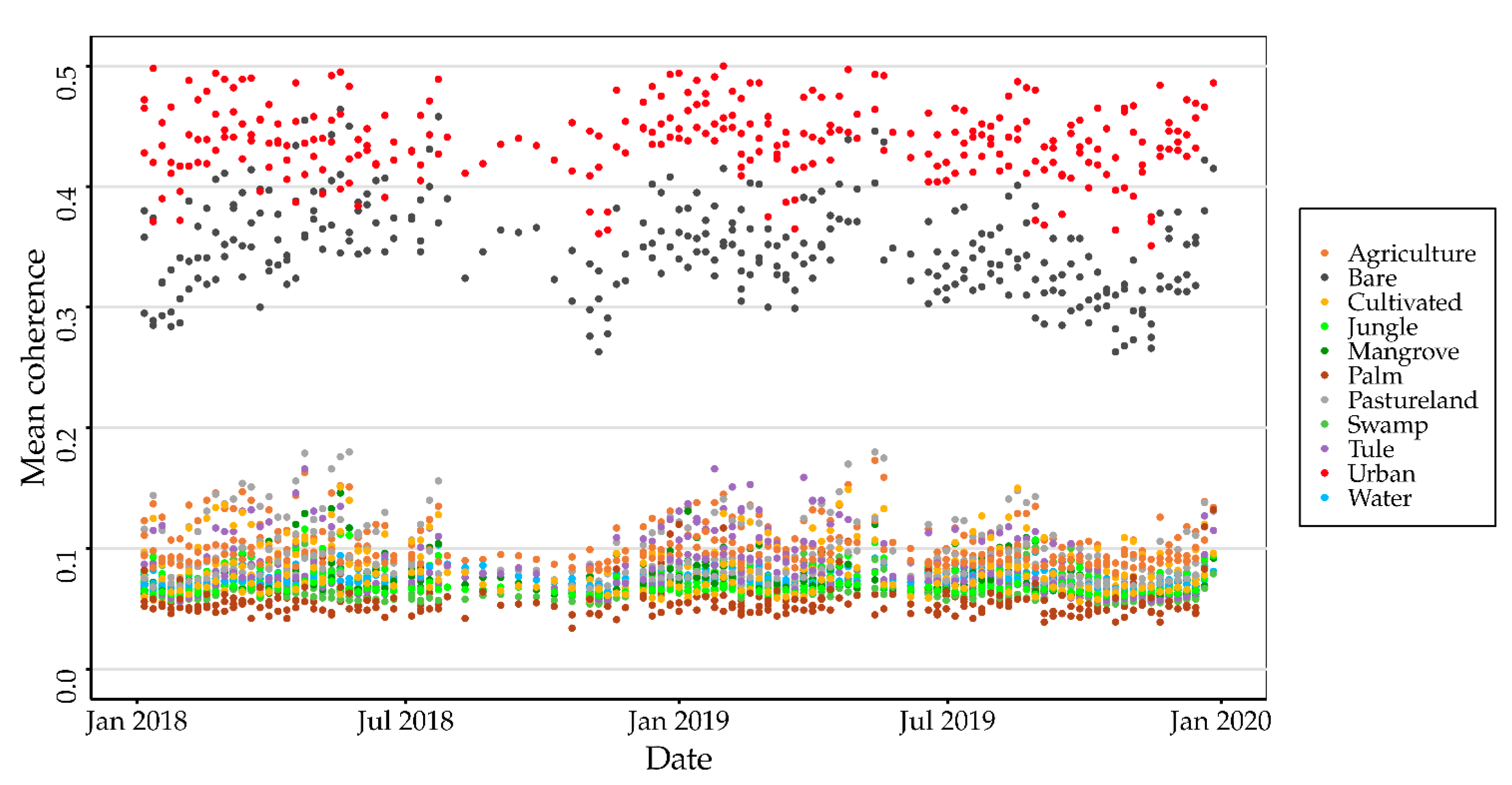


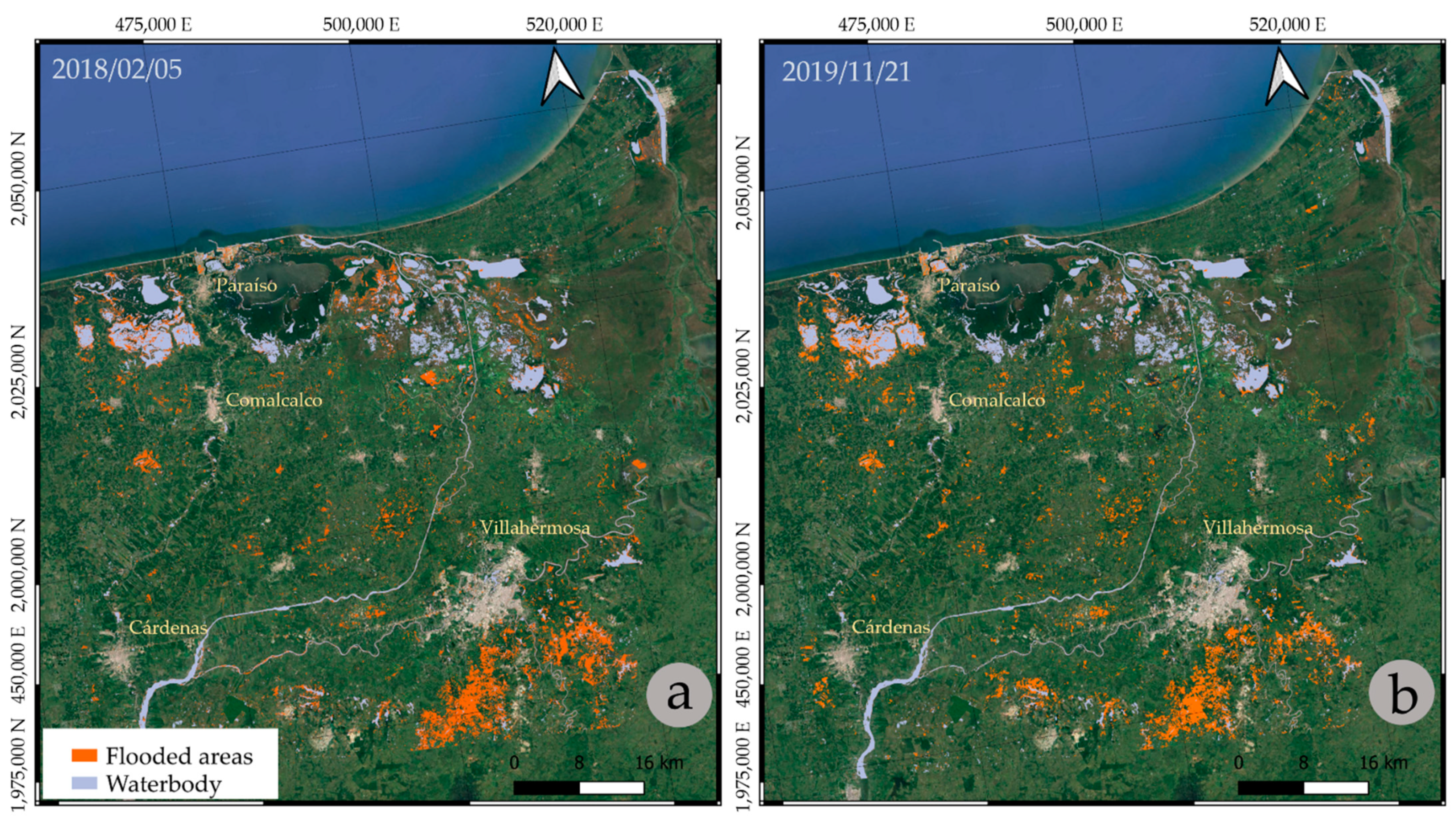


| Dataset | 1 | 2 |
|---|---|---|
| Orbit | Descending | Ascending |
| Mode | IW | IW |
| Sub-Swath | IW3 | IW2 + IW3 |
| Track | 99 | 34 |
| Frame | 530/532 | 54/55 |
| Wavelength (cm) | 5.5 (C-band) | 5.5 (C-band) |
| Polarization | VV | VV |
| Nominal ground resolution (Ground Range × Azimuth, m) | 5 × 20 | 5 × 20 |
| Time span | 2 January 2018–29 December 2019 | 6 January 2018–27 December 2019 |
| Number of images (N) | 115 | 108 |
| Number of Interferometric Pairs (I) | 321 | 290 |
| Image | Date | Format-Mode | Polarization | Land Surface Condition |
|---|---|---|---|---|
| 1 | 6 January 2018 | GRD-IW | VV | Dry |
| 2 | 5 February 2018 | GRD-IW | VV | Wet |
| 3 | 16 October 2019 | GRD-IW | VV | Dry |
| 4 | 21 November 2019 | GRD-IW | VV | Wet |
| Interferometric Pair | Orbital Pass | Bp (m) | Bt (Days) | Mean Coherence |
|---|---|---|---|---|
| 12 February 2019–18 February 2019 | Descending | 93 | 6 | 0.13 |
| 12 February 2019–24 February 2019 | Descending | 70 | 12 | 0.11 |
| 12 February 2019–02 March 2019 | Descending | 76 | 18 | 0.09 |
| 12 February 2019–08 March 2019 | Descending | 80 | 24 | 0.08 |
| Interferometric Pair | Orbital Pass | Bp (m) | Bt (Days) | Mean Coherence | Conditions |
|---|---|---|---|---|---|
| 14 November 2018–20 November 2018 | Descending | −85 | 6 | 0.08 | Wet (flood) |
| 14 December 2018–20 December 2018 | Descending | 82 | 6 | 0.12 | Dry |
Publisher’s Note: MDPI stays neutral with regard to jurisdictional claims in published maps and institutional affiliations. |
© 2022 by the authors. Licensee MDPI, Basel, Switzerland. This article is an open access article distributed under the terms and conditions of the Creative Commons Attribution (CC BY) license (https://creativecommons.org/licenses/by/4.0/).
Share and Cite
Pérez-Falls, Z.; Martínez-Flores, G.; Sarychikhina, O. Land Subsidence Detection in the Coastal Plain of Tabasco, Mexico Using Differential SAR Interferometry. Land 2022, 11, 1473. https://doi.org/10.3390/land11091473
Pérez-Falls Z, Martínez-Flores G, Sarychikhina O. Land Subsidence Detection in the Coastal Plain of Tabasco, Mexico Using Differential SAR Interferometry. Land. 2022; 11(9):1473. https://doi.org/10.3390/land11091473
Chicago/Turabian StylePérez-Falls, Zenia, Guillermo Martínez-Flores, and Olga Sarychikhina. 2022. "Land Subsidence Detection in the Coastal Plain of Tabasco, Mexico Using Differential SAR Interferometry" Land 11, no. 9: 1473. https://doi.org/10.3390/land11091473






